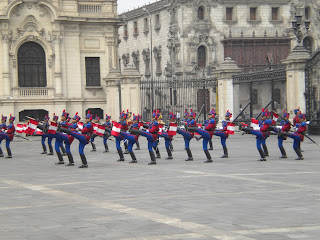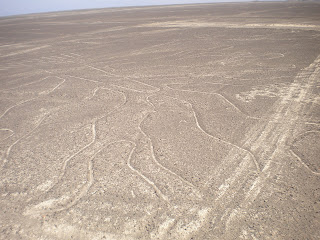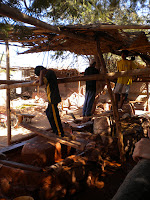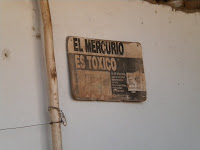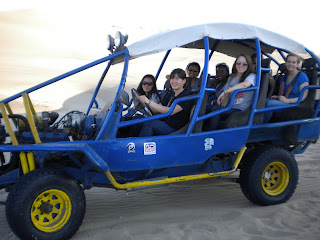 |
| Llamas cutting the grass in front of the Pachacamac Museum |
Nevertheless the majority of Lima's streets house no such beauty, but are instead filled with varying shades of gris. But I truly had not realized this until today because Lima houses so many interesting activities and history.
In the afternoon we went to see more of Lima's rich history at Pachacamac, the ruins of an ancient religious site about 30 min south of Miraflores. On the ride down we passed rows after rows of slums but suddenly we were there: a barren dessert from which rises a few pyramids where years ago the Lima followed by the Inca peoples worshiped the Sun God.
 |
| Rachel and I in front of the Temple of the Sun |
First we saw the vertical brick construction that the Limas used to withstand earthquakes. Since the bricks are able to wobble back and forth they don't fall down and are a good building technique for this seismic area. Next we moved onto the Women's house where special 12-13 year olds live to cook food and perform the ritual dances after each religious ceremony.
 |
| Our guide explaining the different size adobe bricks |
Next we moved forward to look at some of the 16 pyramids uncovered so far. This active restoration site is still teaching archeologists more about different cultures every day, but as of now they know that the size of the adobe brick used for construction can tell which culture built each part of the temples. The large bricks were made by the Icanans while the Waris made the medium sized bricks. Other remains found include cuy, llamas, textiles, pottery, shells from Ecuador, and of course human sacrifices.
At the site of the largest pyramid, the Temple of the Sun, 100 women were found strangled on the 2nd tier facing the ocean. As all the girls in our group gasped the guide told us that they had all been quite drunk on chicha, a liquor made from corn, which tempered our shock a bit, but didn't stop the disbelief. Overall throughout the 26 hectare place over 6,300 mummies have been found so far, although not from sacrifice.
The North-South Road also passes straight through Pachacamac and is where Francisco Pizarro rode in on when he searched for gold and silver from the Incas during Spanish exploration. The road extends north all the way to Ecuador and south to the capital of the Incan territory, Cuzco, where we will head on Sunday.
After the trip we returned to Miraflores and ate dinner at Larcomar, a seaside mall, before catching the reduced priced showing of ¿Qué Pasó Ayer? 2 (aka The Hangover 2) at the cina. (My first time in a movie theater outside of the US!) Thankfully the movie was not cringe-worthily dubbed and we got to listen to English while reading some Spanish here and there. Amusing and horrifying as ever the Hangover series evidently transcends cultural boundaries as the theater was packed and the whole crowd was laughing.
Lessons Learned:
- Only women could weave in Incan culture
- I bought a gourd pot! Not a lesson but I'm very happy with it despite the relatively high price tag and just thought I'd share.
- Dulche de Leche is absolutely delicious and free samples at Havana are the perfect dessert.
- Some things just can't be adequately translated via subtitles...



















